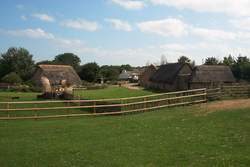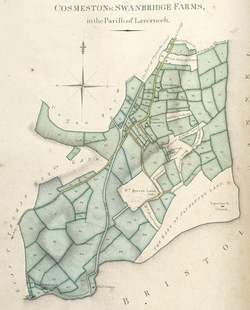Map 23 of the Bute Survey
Cosmeston is a deserted medieval village a few miles south of Cardiff. Not much is known about its history and the reasons for its abandonment, but its main claim to fame now is that part of the village has been reconstructed and opened to the public. As far as I know Cosmeston is the only reconstructed medieval village in Britain.
Before the arrival of the Normans the area around Cosmeston lay within the Welsh kingdom of Morgannwg. Towards the end of the eleventh century Morgannwg was conquered by the Norman lord Robert Fitzhamon and it became the lordship of Glamorgan. The followers of Robert Fitzhamon included the de Costentin family who had come from the Cotentin peninsular in northern France. They were the first lords of the manor of Cosmeston, and they called the village Costentinstune. They built a manor house and perhaps a few dwellings or small farms, but for the next two centuries it appears that little further development occurred. Around 1316 the manor passed into the hands of the de Caversham family.
The buildings that have been excavated date from the fourteenth century. It seems likely that the de Caversham family brought a more planned approach to the development of the community, and a nucleated settlement began to emerge.
Evidence for a series of regular crofts at Cosmeston comes from boundary earthworks that can still be seen today and from the 1824 survey of the South Wales estates of the Marquis of Bute. The very beautiful maps of the Bute survey can be seen at the Glamorgan Archives in Cardiff. You will not be allowed to touch it, but a member of staff will place it in front of you and turn the pages one at a time until you come to Map 23. The medieval road that ran through the village from south west to north east is marked in yellow, and the four crofts can be seen stretched out along the south east side of the road.
It is likely that the village of Cosmeston had started to decline by the end of the fourteenth century, and there is documentary evidence that by 1437 the manor house had fallen into ruin. Difficulties faced by the inhabitants of the village would have included:
· The low lying position of the village. Ditches were constructed to carry water away, but there may still have been frequent flooding.
· The unsettled political situation, with intermittent resistance by local Welsh leaders. In January 1316, for instance, Llywelyn Bren attacked Caerphilly castle, and for the next two months there was conflict and much devastation throughout Glamorgan.
Wikipedia has a good article on Llywelyn Bren.
· The Black Death, the disease (possibly plague) that entered England and Wales in 1348, and broke out again several times before the end of the fourteenth century. As well as causing enormous mortality the Black Death gave rise to major social and economic changes and large scale migration.
Go back to Wikipedia for an account of the Black Death.



